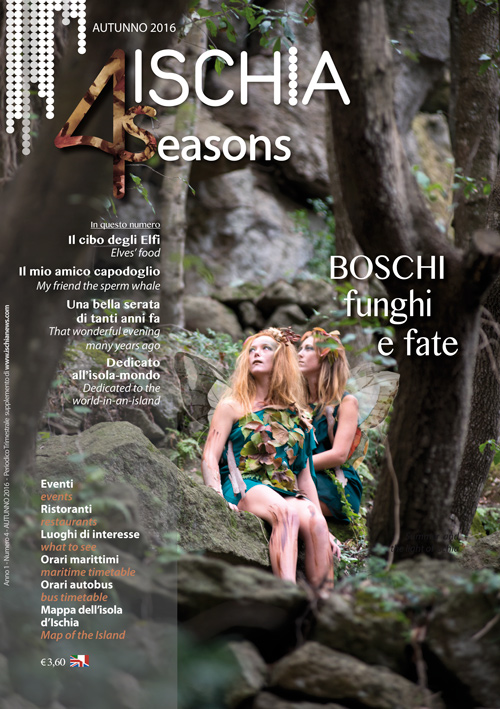Discovering Ischia









































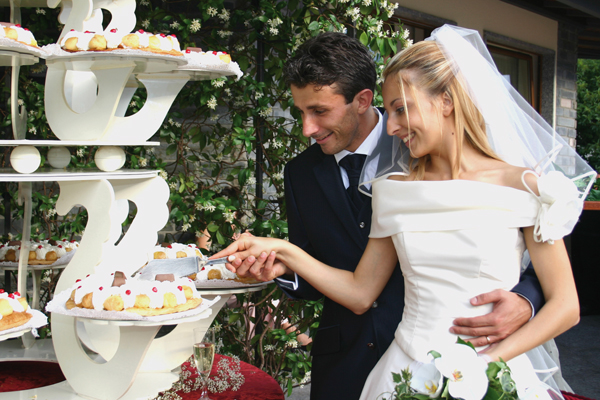
Even if I were not born and grew up here, I’m sure that I would choose Ischia for my wedding. The meaning of the journey when you’re waiting for one hour to dock at the port, pays you back for everything, because despite being an island alive, especially in this time of year, it’s a postcard from any perspective you manage to look at it.
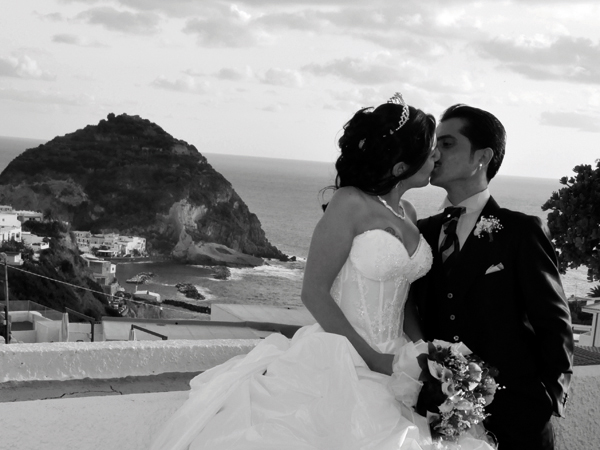
Some time ago on TV it was sent a report dedicated to brides. Apparently there are many Italian women who put aside superstition and choose their own clothe accompanied by their partners. Well! If there is complicity, so be it, especially if the marriage in question is a bit over the top.
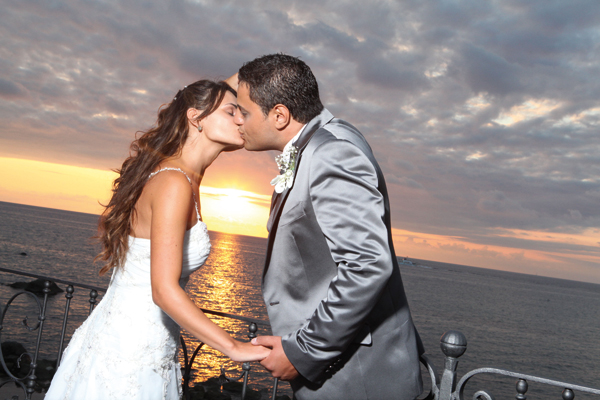
It is just when relationships do not seem to go as you hope, when divorces arrive and the family grows, you feel the need to live the fairy tale, like a movie Happy Ending. For my third imagery marriage (unless you’ve lost count, and so must ask for alimony to her ex-husband that I missed), thanks to ...
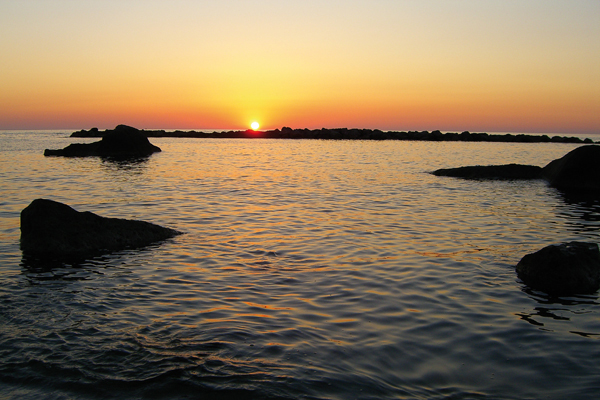
We know that the most exciting moment in the fateful ‘I do day’ is that long, interminable ascent to the churchyard. It's the time of waiting, of the many questions and few answers. It's the time in which among many things to look at, the only one you can see is him who waits smiling and secure on the altar.
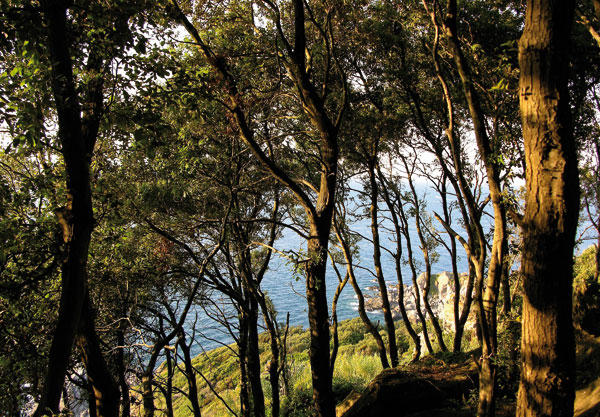
When I'm in a waiting room I like to browse old magazines and newspapers, with the hope of recovering the news and gossip or news that I missed. I opened Vanity Fair, as you do with The Big Book of 1,000 responses, and my eyes ended up on an article by Matteo Mafuggi that talks about alternative weddings. I thought: that’s just for me!

This time instead of trailing and bouquet I thought I’d relax and play the role of guest telling you about the last wedding, organized by Nuages Eventi, which I particularly liked. The theme was that of colors, which includes a beautiful message, which goes beyond the exasperation of hobbies and personal tastes which often require all coordinated.

A unique moment with love and care of a family thanks to the presence of a specialized staff: in short, Hotel Terme Tritone & Resort s.p.a that has years of experience, passed down over time. Nothing is left to chance: to the personal choice of the menu to the decorations.

Few weddings every year can enjoy the special and unique location of the Tower of Sant’ Angelo. The Residence, with privileged views of the precious village of Serrara Fontana, resumes in its dishes the taste of the sea, which surrounds it.

The Park Hotel & Terme Romantica is set in an exceptional location in the exclusive resort of St. Angelo, with breathtaking sunsets that seal the end of the day. It is a versatile location suited to hosting ceremonies of all kinds thanks to its spaciousness and the multiple solution.
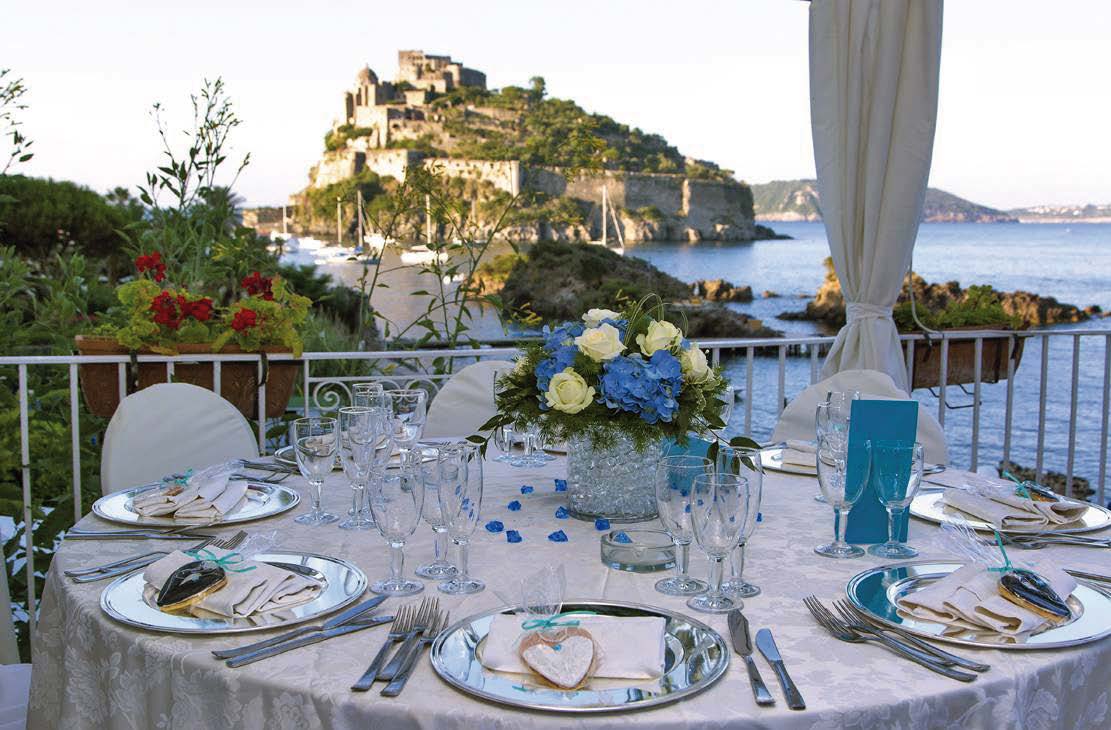
Nestled in the beautiful bay of Cartaromana, located in the Municipality of Ischia, in front of the Aragonese Castle and the seat of the Roman city submerged Aeanaria. Cartaromana is the ideal location to celebrate one of the most important events in life.


1. The Scalfati Building
2. Seminary
3. Corteglia building
4. The Malcovati Building
5. The Onorato building
6. The Cathedral and bell-tower
7. Palazzetto
8. The little house with the courtyard
9. House with little arches
10. The Clock Tower
11. The Lauro Building
12. Santa Maria of Constantinopoli
13. Church of the Holy Spirit
14. The Lanfreschi building
15. Building complex

Period: the beginning of the 18th century
Original use: home.
Today’s use: home.
Roofing: flat, terrazzo-style.
Vaults or attic: barrel-vault, wooden attic.
Stairs: two flights of stairs.
Masonry: Masonry in tuff and lava stones with painted plaster.
Floors: tiles and brickwork.
External decorations: stucco-work and a marble coat of arms.
Scalfati Building - via L. Mazzella
As viewed through a painting by the artist Hackert back in 1789, the Scalfati building only had one floor and was flanked by loggette (little lodges) on its lateral façades
one of which was englobed between two factories because of the expansion of the adjacent Seminary.
The building’s façade is characterized by the arch of the entrance covered with plaster and fake ashlar, juts out noticeably to the point that it provides support to the central balcony of the first floor.
The second floor is very high: the mezzanine level has entries to the balconies.
On the second floor there is a rigid, yet simple, scheme of alternating windows and balconies.
Glossary:
Loggia: a small building open on one or more sides, with arches supported by pillars or columns.
Arch: the width of the opening of an arch or of an arched window.
Ashlar: masonry hangings with projecting elements used as a cornice of portals and windows and also as angular boundary.
Projecting: jutting out.
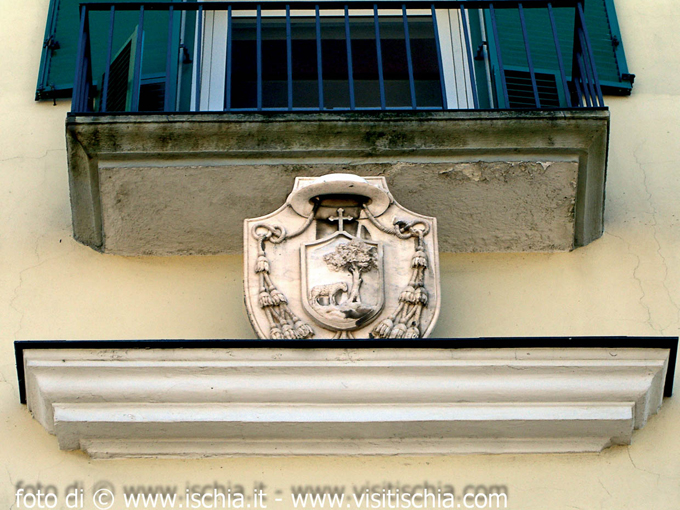
Period: 1741/1823.
Original use: seminary.
Today’s use: bishop’s palace.
Roofing: flat, terrazzo-style.
Vaults or attic: pavilion vaults, flat attic.
Stairs: three flights of stairs.
Masonry: Masonry in tuff stones with painted plaster.
Floors: tiles.
External decorations: decorative stucco-work
The Seminary is found in Via L. Mazzella
The building last fulfilled its original function at the beginning of the twentieth century, then it was converted into today’s bishop’s palace.
The newly constructed building has two floors along which there are distributed two series of rectangular windows. The windows of the first floor are overlapped by triangular gables with cornices in stucco, those of the second floor are overlapped by simple projecting corbels. There is only one balcony on the first floor which corresponds with the barrel-vault of the entrance; this presents a doublemodanatura with two superimposed gables and a shell at the center with its vertex pointing upward.
Along the façade two white stucco bands decorated withbugne smooth ashlars alternating with diamond points mark the boundary of the original building expanded in 1823 as is seen in the ‘chiave d’arco’ of the little portal.
Glossary:
Tympanum: internal space of the gable limited by the cornice.
Moulding: decorative architectural element which forms a continual rectilinear pattern along the border of a structure.They can have various shapes or outlines.
Bugne: square stones, more or less of regular shapes, jutting out from a building’s surface and detached from one another with the help of the blunted part of the edges.
Keystone: the stone that closes the top of the arch and acts as a hinge for the entire structure. It is formed by an ornate wedgeshaped element at times with a plastic pattern.

Period: the 16th century.
Original use: religious building.
Today’s use: religious building.
Roofing: sloping roof, bowl-shaped extrados.
Vaults or attic: lunette barrel-vault.
Stairs: two flights of stairs.
Masonry: Masonry in tuff and lava stones with painted plaster.
Floors: square marble pieces.
External decorations: decorative stucco-work.
The Brotherhood of Santa Maria di Constantinopoli is found in Via L. Mazze
This building is characteristic because of its portal which slightly projects outward and is circumscribed by a flat cornice. On the entrance’s ‘fornice’ a rich plastic fastigium stands out, decorated in white stucco that serves as a cornice for the family’s noble coat of arms. The cornice extends upward around the window with a low arch onto which the cornice ends with the shell and its vertex in the upward position.
Besides the entrance, a flight of steps leads to the internal courtyard whose side has a colonnade that supports the gallery from which several steps lead to the apartments.
Glossary:
Gable end: the terminating part of a structure, synonym of ‘frontone’ (gable).

Period: the second half of the 16th century.
Original use: defence tower.
Today’s use: home.
Roofing: a terrazzo-style roof.
Vaults or attic: pavilion vault.
Stairs: two flights of stairs.
Masonry: Masonry in lava stones with painted plaster.
Floors: brickwork.
External decorations: portal made of piperno.
Furnishings: etching of the Castello Aragonese of Philip Hackert.
The Malcovati building - via Marina
The Malcovati Building rises on the primitive coastal tower constructed by Orazio Tuttavilla, governor of the island during the second half of the 16th century as a result of the order set out by the Royal Palace Court of Naples of 1563 that favoured the construction of maritime towers for defence against pirates.
The territory was given by the Augustinians so that the village and the convent could be guarded but already in 1675 the tower was passed over to a private owner and was widened.
In a painting by Heckert back in 1789 the lateral constructions are visible, while in a design by P. Mattei which dates back to 1847 these already reached the height of the tower. One can access the building through two entries: one is from the side on the sea, through a flight of steps dug into the rock; the other is in the opposite façade through the main entry (made of piperno) which opens onto the piazzetta.
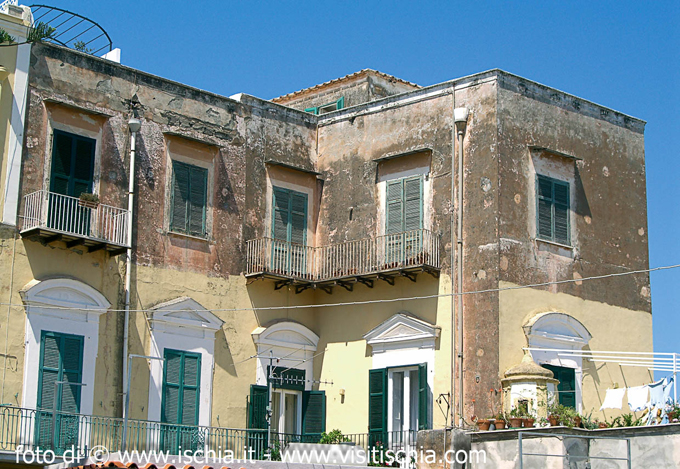
Period: the 18th century.
Original use: home.
Today’s use: home.
Roofing: flat, terrazzo-style.
Vaults or attic: pavilion vault.
Stairs: three flights of stairs.
Masonry: Masonry in tuff and lava stones with painted plaster.
Floors: tiles and brickwork.
External decorations: cornices and gables in stucco.
Underground structures: cellars.
Onorato building - via L. Mazzella
The two-storey building expands on the map in an L shape. One can access the building through two entries: one in Vico Marina, the other in Vico Stradone.
Originally the façade facing the sea presented a spacious portico with open, large arches which today are partially closed due to the ‘tompagnature'.
It was constructed during the second half of the 18th century by the Buonocore family and as a result of the marriage of the young heir Marianna with Nicola Onorato. The building took Nicola’s family name.
During the first half of the 19th century the archpriest Vincenzo Onorato lived here, author of an important manuscript entitled “Ragguaglio historico topografico dell’Isola d’Ischia”.
From the landscape perspective, together with the Malcovati building this building’s site is on high ground.
Tompagnatura (total/partial closure of a room/space by building a wall): the closure of an opening through the construction of walls.
Nave: a longitudinal space between two rows of columns and pillars or between external walls.
Apse: a semi-circular hollow covered by fl sphere façade.
Tambour: the structure at the base of a dome.
Transept: the transverse nave that intersects the longitudinal naves near the apse.
Presbytery: the part of the church exclusive to the officiating members of the clergy. It is separated by a low enclosure.
Suspended arches: a series of little arches either suspended on corbels or lacking visible support.
Lantern: an architectural structure placed as the crown of the dome.
Period: the 13th century; the beginning of the 17th century; 1751.
Original use: sacred place.
Today’s use: sacred place.
Roofing: flat with an extrados dome, elliptical little domes.
Vaults or attic: lunette barrel-vault.
Masonry: Masonry in tuff and lava stones with painted plaster.
Floors: white and black marble squares.
External and internal decorations: decorative stucco-work.
The Cathedral - via L. Mazzella
At one time this church was occupied by the Eremiti brothers of Saint Augustine who lived in an attached convent which today has been transformed into private homes.
The façade of the church presents two superimposed rows and a gable that mainly takes up the central part, while on the sides two scrolls decorate the contour.
The layout of the basilica with three naves has a Latin cross when seen from the circular apse.
A wide dome with a lantern is on a high tambour perforated by four three-lobed windows that hand over the connection between the main axis and the wide transept.
Seven marble altars are divided in the lateral naves and in the central nave in front of the entrance. the latter being surrounded by the choir where there are old walnut choir stalls.
To see:
Ebony cross; the table of Saint Thomas Aquinas; the baptismal font; a painting by G. Diano.
Bell-Tower - The bell-tower is found in Lungomare Aragonese
Period: the first half of the 15th century.
Original use: defense tower.
Today’s use: bell-tower.
Today’s use: bell-tower.
Vaults or attic: pavilion vault.
Stairs: spiral stairs.
Masonry: pumices and lava stones with mortar plaster.
Floors: concrete.
External decorations: tores subdivided in lava stones, corbels.
The tower was erected as a concession made by Alfonso d’Aragona in 1433. Its purpose was to defend the village. It was restored after 1492. It was transformed into a bell-tower at the beginning of the 16th century.
The tower has a square base and it rises next to the east wall of the presbytery of the Cathedral.
Today it displays in its architectural traits the old role of the defense building: the base slopes, the curbs of lava stones are placed at the junction point of each of the the three planes and the loop-holes.
The loop-holes, together with the suspended little arches, are along the final part of the roof onto which the dome and the little lantern lean. The dome and the little lantern were already visible in the affresco of the early years of the 16th century painted in the Guevara tower.
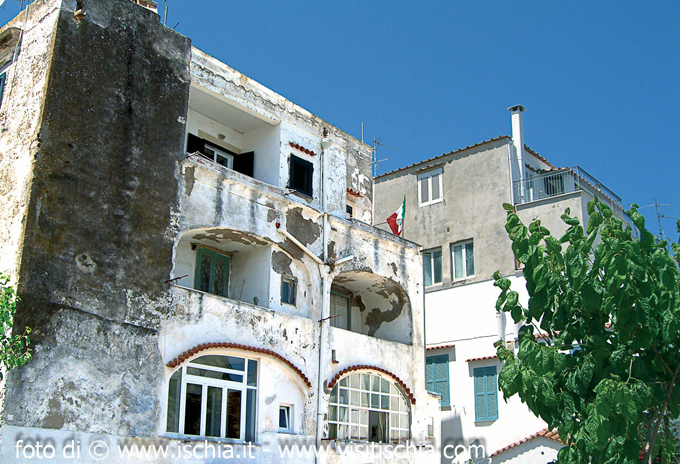
Period: the 18th century.
Original use: home.
Today’s use: home.
Roofing: flat, terrazzo-style.
Vaults or attic: barrel-vault, wooden attic.
Stairs: two flights of stairs.
Masonry: Scaled masonry made of lava stones with unrefined plaster.
Floors: concrete pavement of lapillus and bricks.
Outdoor decorations: stucco frames.
Palazzetto - via Giovanni da Procida
During the days preceding the restoration plans of 1878, the palazzetto directly licked up the sea.
The prospect that now faces the actual via S.G.G della Croce presents an overlapping of rounded arches on two planes supported by pillars. An opening was created in the overlapping of these arches so as to allow for the passage from one ‘loggetta’ to the next. The particular architectural trait of the palazzetto is the connection of the pillars in the corner which occurs along with the rounding off of the corner.
The superior arch is bordered by a large cornice in stucco which is slightly jutting outward.
Period: the 18th century.
Original use: home.
Today’s use: home.
Roofing: flat, terrazzo-style.
Vaults or attic: pavilion vault, wooden attic.
Stairs: two open flights of stairs.
Masonry: Masonry in tuff and lava stones with painted plaster.
Floors: concrete pavement of lapillus.
Little house with courtyard - via G.G. della Croce
This little structure is an example of the spontaneous architecture of the Baroque period.
It was saved from the plan of the block’s destruction in 1878, a plan to reorganize the village.
The building has a courtyard with a rectangular layout and an arbour enclosed in a boundary wall which is interrupted at the entrance by two simple volutes. The façade of the building presents an entrance with a low arch which supports the gallery. Access to the gallery is possible by taking the external staircase onto which the upper floor’s rooms face. A second staircase of two flights of stairs directly reaches the upper floors.
Period: the 18th century.
Original use: home.
Today’s use: home.
Roofing: flat, terrazzo-style.
Vaults or attic: wooden attic.
Stairs: two flights of stairs.
Masonry: Masonry in lava stones with painted plaster.
Floors: tiles and concrete pavement of lapillus.
External decorations: corbels in lava stones.
House with little arches - via Giovanni da Procida
This building expands out to two floors. One can access the first floor via two entries: one has a rounded arch, the other a low arch interrupted by the top of arches (chiave). The balcony of the first floor is leaning on the corbels connected by little arches in the center and then enclosed by a wide arch from which two openings were created, this being a recurring solution in all constructions found in the village.
A picturesque spur of rounded extremities has been inserted in the construction probably as a result of the need to reinforce the building.
Glossary:
Key brick: the top of an arch.
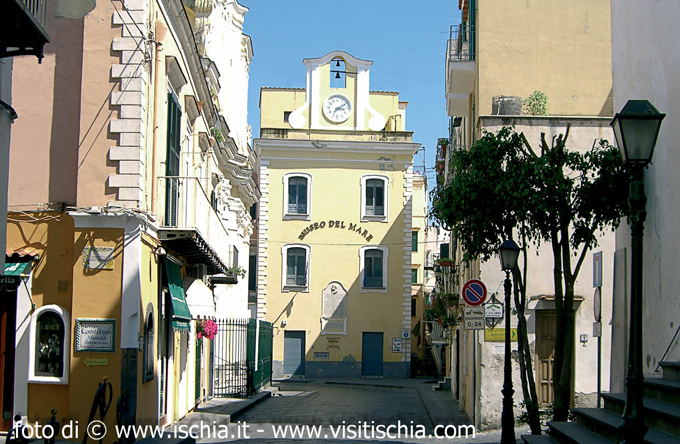
Period: the 16th century.
Original use: public building.
Today’s use: museum.
Roofing: flat, terrazzo-style.
Vaults or attic: pavilion vault, flat attic.
Stairs: three flights of stairs.
Masonry: Masonry in tuff and lava stones with painted plaster.
Floors: brickwork.
External decorations: clock, marble memorial tablet.
The Clock Tower is found in Via L. Mazzella, 77
Since its foundation, the Clock Tower has always fulfilled its role as being the site serving as the Town Hall. In 1898, in a location plan to reorganize the entire village, it was mentioned as the “Municipio” (Town Hall). At the beginning of the 20th century, towards the twenties, the municipal site transferred over to the Mazzella building (Palazzo Mazzella).
The rooms of the Tower were used as elementary school rooms up until 1967. On December 15, 1996 the tower was inaugurated the Museo del Mare (the Sea Museum). The building’s shape as seen today dates back to 1759. During these years the ‘Decurioni’ (Members of Parliament of the ‘universities’ [today’s municipalities]), restructured the Tower with structures such as the Board room, various offices, and the use of the first floor as a jail. Until 1730, the general assemblies took place in the village’s tower (Torre del Borgo). In 1759, the tower was endowed with a municipal clock. At one time the clock’s face was marble; in 1960 it was substituted with a bright clock-face. Still in 1759, a basin in tiburtine rock was placed near the tower by the administration. Besides the 19th century memorial tablet commemorating the death of King Victor Emanuel II, today we can still read on the building’s frontispiece the more ancient and smaller tablet suggested by the Baron Antonini for the fountain: “Aquam ex fonte buceti a.d. ivmp publico aere derivatam la broque ex tiburtino lapide ornatam et turri in qua concilia fierent adpositam addito orario decuriones pthaecusani utendam fruendam civibus dedurunt ad 1759”[*].
[*] "The authorities gave the water to the citizens so that they could use it with joy. With the help of everyone’s money, it was obtained from the fountain of Buceto and now squirts in the beautiful basin of tiburtine stone.
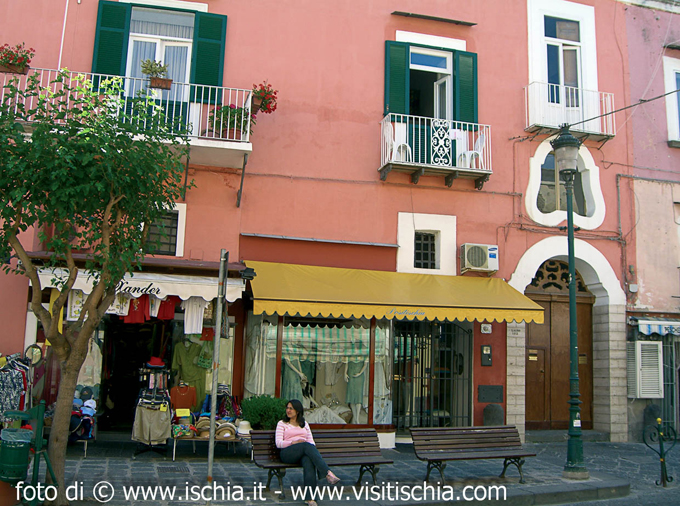
Period: End of the 18th century.
Original use: home.
Today’s use: home, stores.
Roofing: flat with 2 balconies.
Vaults or attic: barrel-vault, wooden attic.
Stairs: two flights of stairs.
Masonry: Masonry in tuff and lava stones with painted plaster.
Floors: brick.
Outdoor decorations: archittettonic stucco and decorative.
Palazzo Lauro - via L. Mazzella
It is difficult to consider the building’s actual state to determine its original nucleus dating back to 1614—since then many additions have been made. Two elements remain unaltered: the rectangular layout and the layout of the two entrances. One entrance faces onto via Mazzella, inserted in one of the three wide arches that supports the balcony, the other is on the opposite side of the building and is upheld by the typical three-lobed window that illuminates the open stairwell. The mezzanine in this case is displaced to the second floor, as one can deduce
from the more elaborate decorations that adorn the second row of openings.
Windows and balconies are in fact upheld by triangular gables which alternate with those that are curved and supported by stucco corbels. It is possible that this layout was dictated by the view of the sea, a privilege stipulated by the Lauro family and the Augustinian brothers in a document of the 700’s. The Augustinian brothers tried not to build buildings that went above the first floor of the properties on the opposite side of the road otherwise their home would be deprived of the panorama.
On one hand, the building rose in an excellent location for a lovely panorama and it was also close to the main religious buildings (the Santo Spirito Church and the Chiesa degli Agostiniani); on the other hand, it enjoyed the possibility of having a direct rapport with the countryside thanks to a path accessible from the back entrance.
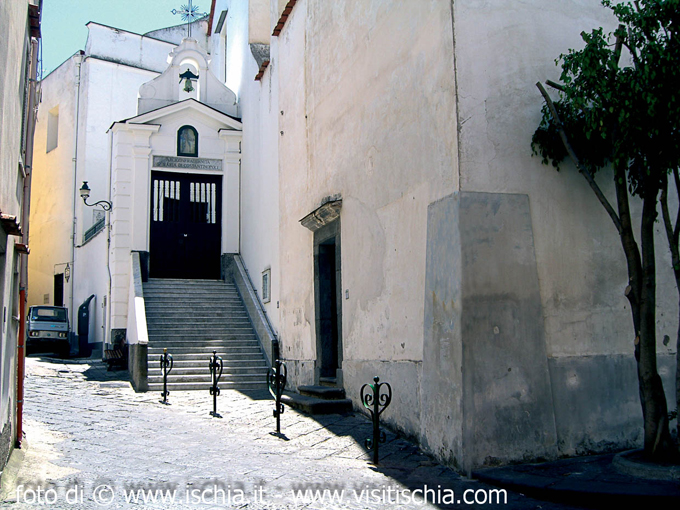
Period: the 16th century.
Original use: religious building.
Today’s use: religious building.
Roofing: flat, terrazzo-style, bowl-shaped extrados.
Vaults or attic: lunette barrel-vault.
Stairs: two flights of stairs.
Masonry: Masonry in tuff and lava stones with painted plaster.
Floors: marble squares
External decorations: decorative stucco work.
Confraternita di S.M. di Costantinopoli - via L. Mazzella
The Brotherhood of Santa Maria of Constantinopoli was constructed during the 16th century to replace the ancient Cossa Chapel dedicated to Saint Sofia (16th century). The construction of this building was possible due to the work of the ranks of fishermen and artisans of the area we today know as the Celsa village.
Two flights of steps give access to an open atrium, enclosed by a low façade that presents two golden doric lesene that support the triangular gable a votive stall stands out on the gableedicola and the upper arch with terminates with two lateral volutes, a recurring element in the local churches.The second façade does not present any elements of much importance; the inside, a nave with one nave barrel-vault and is enriched with walnut stalls along the lateral walls.
To see:
The affrescoes representing episodes from the Old and New Testament in the lunette of the lateral arches; the particular flight of stairs typical of the minor architecture of the time (found in the sacristan).
Glossary:
Lesena: pillar slightly projecting, leaning against a smooth wall, used as decorative element.
Frontone: structure shaped like a large isosceles triangle that acts as a crowning.
doors, windows, niches and shrines.
Aedicule: small structure in the form of niche tabernacle or temple positioned to protect the sacred images.
Period: the seventeenth century., Changes between 1652-1674.
Original use: religious building.
Today's use: religious building.
Coverage: a sloping roof.
Vaults or attics: barrel vaults with lunettes
Stairs: Front entry staircase.
Masonry techniques: stone masonry of tufa and lava stone with painted plaster.
Floors: marble squares.
Outdoor decorations: piperno portal.
Interior decoration: decorative stucco, marble altars.
Church of the Holy Spirit - via L. Mazzella
Near the Confraterita is the Church of the Holy Spirit, founded by the sailors of the village of Celsa, the site of the Hospital for the sick poor, founded in 1620 and decommissioned in 1652.
he new temple was opened to public worship in 1674 and maintained with voluntary income-class sailors.
The facade is bare except for the doorway and a window piperno trefoil son the pediment along the lines of the vault cover.
A pyramidal tower rises against the right side of the facade. It is divided into several floors, the latest being surmounted by a dome covered with pear-shaped yellow and green glazed tiles.
The plant has a single nave basilica, built on a Latin cross, with an altar and eight lower ones along the sides, all carved in marble.
The crossing of the transept is underlined by a low dome extrados brings a sloping roof resting on the outer walls.
At the door of the temple is a shrine of ancient marble column that was picked up at sea by fishermen.
To see:
The stucco covering the walls and the frescoes on the ceiling of the dome fresco of the castle (XVI8 sec) in the sacristy.
Glossary:
Trifoil: divided into three potions rounded.
Extrados: convex surface of an arc or of a time.
Period: the beginning of the 18th century.
Original use: home.
Today’s use: home, commercial activitiesli.
Roofing: flat, terrazzo-style.
Vaults or attic: barrel-vault, cross vault, wooden attic.
Stairs: three flights of stairs.
Masonry: Masonry in tuff and lava stones with painted plaster.
Floors: tiles and brickwork.
Palazzo Lanfreschi - via L. Mazzella
The Lanfreschi building was constructed in the 18th century and was used as the temporary site of the ‘General Members of Parliament” from 1730 to 1750. From the architectural point of view, this building presents a distinct façade of vertical bands that frame the openings of the first and second floors.
The balconies and the windows are upheld by tight cornices slightly jutting outward. The two balconies of the first floor are supported by corbels in lava stones.
One can access the building via a portal that lets you into a lobby with a barrel- vault. From here wide arches upheld by pillars determine the entrances for the apartments and offer a scenographic snapshot that makes the green garden stand out and appear raised with respect to the background.

Period: the 18th century.
Original use: home.
Today’s use: home.
Roofing: flat with a U shape.
Vaults or attic: pavilion-vault, wooden attic.
Stairs: an external flight of stairs and one internal flight of stairs.
Masonry: Masonry in tuff and lava stones with painted plaster.
Floors: brickwork and concrete pavement in lapillus.
External decorations: corbels in piperno supported by balconies.
This is found in via G.B Vico
In 1847 the artist P. Mattei painted a foreshortening of the actual via G.B. Vico as he was fascinated by the particular nature of the construction that has around it a wide flight of stairs.
In the background the façade of the building is interrupted by various openings: on the long side of many structures various wide arches stand out on several floors; on the short side a delightful loggetta, at one time covered, offers a good support to the scenographic superimposition of the floors.

History
The thermal waters of the Island are well known and used since ancient times. Already the first Euboeans settlers (eighth century AC), as evidenced by numerous archaeological finds at the site of Pithecusa and kept at the Archaeological Museum of Villa Arbusto in Lacco Ameno, appreciated and used the waters of hot springs on the island. The Greeks used the hot springs for restoring spirit and body and as a remedy for healing the aftereffects of war wounds (in pre-antibiotic age!) By attributing to the waters and vapors that bubbled up from the earth with supernatural powers, not by chance at each spa town stood temples dedicated to deities like Apollo at Delphi. Strabo, greek historian and geographer, mentions in his monumental work the geographical island of Ischia and the virtues of its hot springs (Geograph. Lib. V). If the Greeks were the first people to know the powers of hot springs, the Romans praised as a tool of healing and relaxation through the creation of public Thermae and the many safe and profitable source of the island (as the votive tablets found at Source Nitrodi Barano of Ischia, where stood a temple dedicated to Apollo and the Nymphs Nitrodi, guardians of the water) without lavish settlements. In fact, on the island has not been found, as instead in Rome and other ancient spas, majestic ruins of the Baths probably volcanic eruptions and earthquakes, which frequently have violently shaken the cliffs.

Ischia Terme, the wellness centers, le natural hot springs and thermal parks
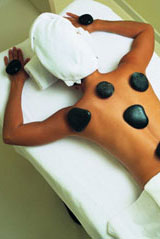 The island of Ischia, already rich in hot springs from numerous therapeutic virtues, renowned worldwide for the Spa of Ischia, boasts also a fortunate geographical position that ensures the entire island territory climatic and environmental conditions ideal for both body and spirit. Ischia and its spa, or rather spa of Ischia, hot springs, parks, spas, wellness centers, in an environment made up of rocky cliffs Epomeo from the rolling hills covered with vineyards, from relaxing pine forest, the fresh sea breeze, the beaches and the many, evocative landscapes make the ancient land of Inarime a sweet enchanted garden where you can enjoy the beneficial effects of the springs of eternal youth.
The island of Ischia, already rich in hot springs from numerous therapeutic virtues, renowned worldwide for the Spa of Ischia, boasts also a fortunate geographical position that ensures the entire island territory climatic and environmental conditions ideal for both body and spirit. Ischia and its spa, or rather spa of Ischia, hot springs, parks, spas, wellness centers, in an environment made up of rocky cliffs Epomeo from the rolling hills covered with vineyards, from relaxing pine forest, the fresh sea breeze, the beaches and the many, evocative landscapes make the ancient land of Inarime a sweet enchanted garden where you can enjoy the beneficial effects of the springs of eternal youth.
Ischia.it and the spa of Ischia
Spa of the island of Ischia
 The thermal waters of Ischia are well known and used since ancient times. Already the first settlers Euboeans (eighth century. BC), as evidenced by the numerous archaeological finds at the site of Pithecusa and kept at the Archaeological Museum of Villa Arbusto in Lacco Ameno, appreciated and used the waters of the hot springs on the island. The Greeks in fact used the thermal waters to restore the spirit and the body and as a remedy for healing the aftermath of war wounds (in the pre-antibiotic era!) by attributing to the waters and vapors that gushed from the earth supernatural powers, not by chance at each spa town rose temples dedicated to deities such as Apollo at Delphi. If the Greeks were the first people to know the powers of the thermal waters, the Romans praised as a tool of healing and relaxation through the implementation of public Thermae and used it safely and profitably numerous sources of the island, the island did not in fact have been found, as is in Rome and in other spas of antiquity, imposing ruins of the Baths probably to the volcanic eruptions and earthquakes that frequently have violently shaken the cliffs. The decline of the power of Rome coincided with the abandonment of the use of bathing even in Ischia: there are not indeed traces of water use in the Middle Ages. Talking about Spa and hydrotherapy we refer also to the Renaissance and a decisive impetus to the modern spa medicine given by Giulio Iasolino, a Calabrian physician, professor at the University of Naples, who towards the end of 1500, attracted by the climate and the phenomena of secondary volcanism (fumaroles and hot springs), realizing the therapeutic potential of the spa, carried out a thorough survey of the sources of the island (for the first time is the hydrogeological wealth of the isle), he identified the composition of the water and performed detailed comments about their effects on many diseases that plagued his contemporaries. Since ‘600 to half of the ‘900 were built in the vicinity of the most famous hot springs, several factories and facilities that made the island of Ischia a renowned international destination of wellness where people treated many diseases of the body, and not only , celebrities such as Giuseppe Garibaldi, after the battle of Aspromonte, Count Camillo Benso di Cavour, Arturo Toscanini. Since the sixties, thanks to the foresight and entrepreneurial intuition of Cav. Angelo Rizzoli, the Island of Ischia and its waters are opened to mass tourism and an intense scientific activity consecrates thermal cures to the rank of alternative therapies for the treatment of many diseases already perfectly described by Iasolino.
The thermal waters of Ischia are well known and used since ancient times. Already the first settlers Euboeans (eighth century. BC), as evidenced by the numerous archaeological finds at the site of Pithecusa and kept at the Archaeological Museum of Villa Arbusto in Lacco Ameno, appreciated and used the waters of the hot springs on the island. The Greeks in fact used the thermal waters to restore the spirit and the body and as a remedy for healing the aftermath of war wounds (in the pre-antibiotic era!) by attributing to the waters and vapors that gushed from the earth supernatural powers, not by chance at each spa town rose temples dedicated to deities such as Apollo at Delphi. If the Greeks were the first people to know the powers of the thermal waters, the Romans praised as a tool of healing and relaxation through the implementation of public Thermae and used it safely and profitably numerous sources of the island, the island did not in fact have been found, as is in Rome and in other spas of antiquity, imposing ruins of the Baths probably to the volcanic eruptions and earthquakes that frequently have violently shaken the cliffs. The decline of the power of Rome coincided with the abandonment of the use of bathing even in Ischia: there are not indeed traces of water use in the Middle Ages. Talking about Spa and hydrotherapy we refer also to the Renaissance and a decisive impetus to the modern spa medicine given by Giulio Iasolino, a Calabrian physician, professor at the University of Naples, who towards the end of 1500, attracted by the climate and the phenomena of secondary volcanism (fumaroles and hot springs), realizing the therapeutic potential of the spa, carried out a thorough survey of the sources of the island (for the first time is the hydrogeological wealth of the isle), he identified the composition of the water and performed detailed comments about their effects on many diseases that plagued his contemporaries. Since ‘600 to half of the ‘900 were built in the vicinity of the most famous hot springs, several factories and facilities that made the island of Ischia a renowned international destination of wellness where people treated many diseases of the body, and not only , celebrities such as Giuseppe Garibaldi, after the battle of Aspromonte, Count Camillo Benso di Cavour, Arturo Toscanini. Since the sixties, thanks to the foresight and entrepreneurial intuition of Cav. Angelo Rizzoli, the Island of Ischia and its waters are opened to mass tourism and an intense scientific activity consecrates thermal cures to the rank of alternative therapies for the treatment of many diseases already perfectly described by Iasolino.
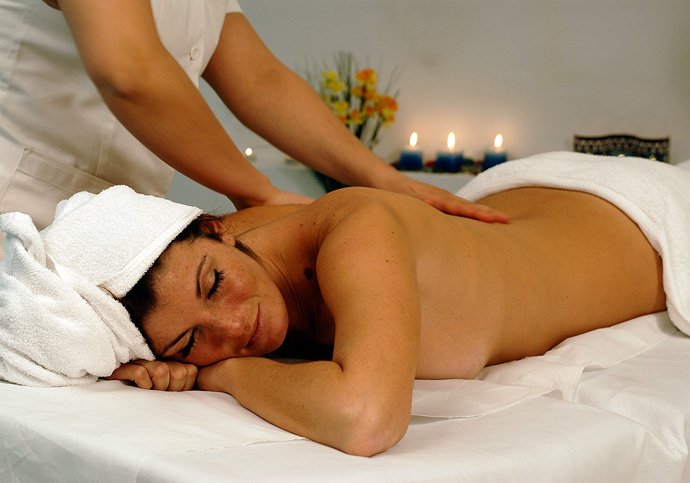
A simple and natural remedy to defend against colds and bronchitis, typical evils of winter. Lately there has been a growing increase in the use of thermal therapy for the treatment of the respiratory system. This is because has been shown a strong capability of remedial and normalizing the thermal waters which, in addition to restoring the normal functions of the device, protect the mucous membranes of relapse.
Muoversi, camminare sono atti che ognuno di noi compie ogni giorno ed a cui non riserviamo molta attenzione sino al momento in cui tali atti divengono difficoltosi o dolorosi.
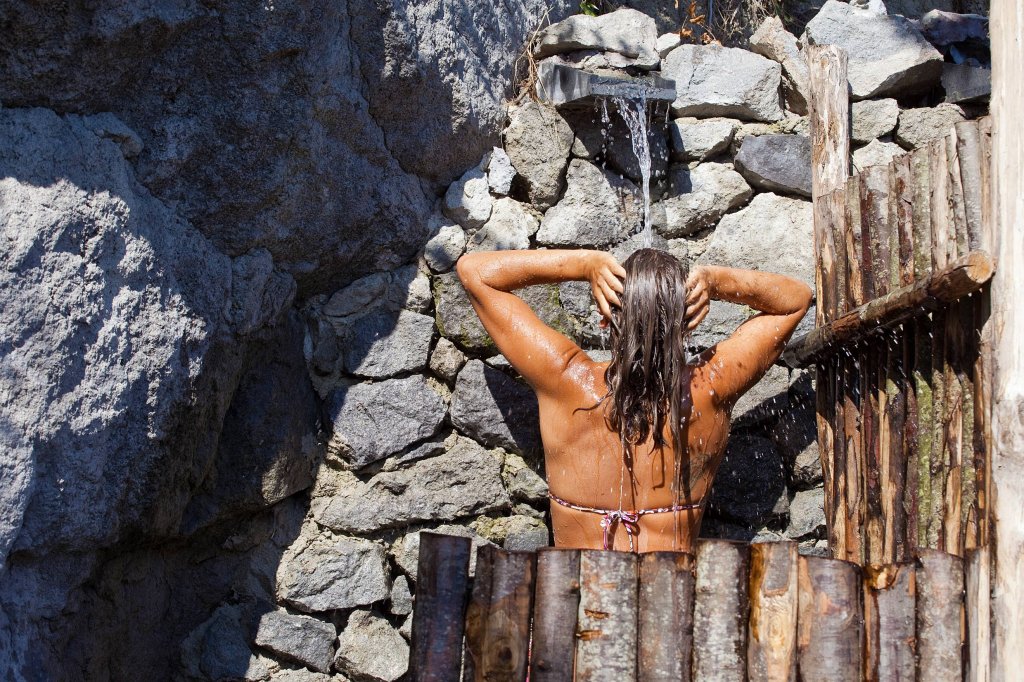
It is not uncommon to go to a spa to improve the welfare of their skin. There are many skin diseases that benefit from spa treatments and numerous spas specialize in skin diseases: psoriasis, eczema, dermatitis, but not only.
Moreover, it is proven and accepted even by the NHS (National Health System) that a dermatological thermal cure even if only one week can give you great benefits and improve the quality of skin affected by problems. The baths in thermal water are useful to relieve skin irritation and redness.
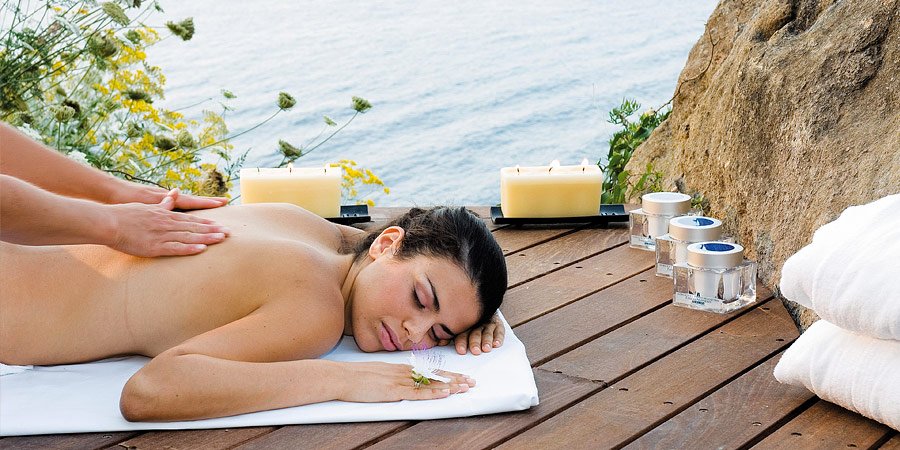
A valuable aid to combat gynecological problems comes from the thermal waters rich with minerals. Baths, pelvic mud, vaginal douches and local aerosol raise problems of many chronic inflammatory disorders such as adnexitis, vaginitis, the results of surgery, pelvic inflammation, sometimes contributing cause of some forms of infertility. Spa treatments are also excellent in the treatment of infections and candidiasis. The well-being of women is put in the foreground, and the atmosphere and the relaxed atmosphere contribute to the benefits that the thermal waters bring to therapy gynecology.

The Thermal treatments are a must for those who need to recharge and leave behind the stress of everyday life, stem from ancient customs and they are still very valid to combat many ailments.
Using techniques that offer Spa Treatments trying to get back in shape and psychological well-being thanks to the steam bath, and massages to mud therapy, treatments with essential oils and even with stones placed in energy points of the body.











More Articles...
- Welness Hotel Le Canne
- Terme Colella
- Terme Il Gattopardo
- Venus Cytarea Parco Teresa
- Hotel Punta Imperatore & Beauty
- Mezzatorre Resort & Spa
- Blue & White Thermal Spa Paradiso
- Tritone Terme e Beauty
- Benessere La Bagattella
- Approdo Health & Beauty Center
- Terme Zì Carmela
- Terme Fiola
- Idroterme Olympus
- Terme di Cavascura
- Parco Smeraldo Terme
- Terme Hotel San Giorgio
- Terme Stella Maris
- Thermal spring of Sorgeto
- Buceto spring
- Nitrodi springs
- The Fumarolas of Sant'Angelo
- Negombo Thermal Park
- Beach park il Giardino Eden
- Thermal gardens Aphrodite - Apollon
- Thermal Park Giardini Poseidon
- Thermal Park Romantica
- Thermal Park Castiglione
- Source of Ninfe Nitrodi
- Ischia le Terme della Bellezza
- Ischia Beauty
- Ischia Thermae


















